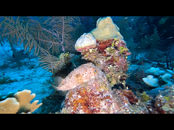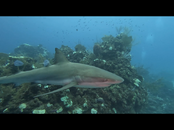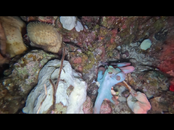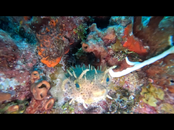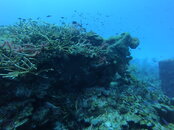- Home
- Forums
- Regional Forums & Dive Clubs
- Greater Caribbean & Bermuda
- Greater Antilles
- Cayman Islands
You are using an out of date browser. It may not display this or other websites correctly.
You should upgrade or use an alternative browser.
You should upgrade or use an alternative browser.
Grand Cayman coral - white like snow
- Thread starter Saboteur
- Start date
Please register or login
Welcome to ScubaBoard, the world's largest scuba diving community. Registration is not required to read the forums, but we encourage you to join. Joining has its benefits and enables you to participate in the discussions.
Benefits of registering include
- Ability to post and comment on topics and discussions.
- A Free photo gallery to share your dive photos with the world.
- You can make this box go away
Where in Belize?Sadly we just returned from Belize and there is white coral everywhere. I have never seen it so bad. And oddly I also saw some bright pink and a lot of bright yellow to almost neon.
Turneffe but mostly Lighthouse.Where in Belize?
A few screen shots from a fellow diver. Eric hasn’t downloaded his videos yet.
Attachments
One year ago, Grand Cayman had already suffered from SCTLD ripping around the entire island. Little Cayman and Cayman Brac did not experience that.I dove GC one year ago, before the high temps of this past summer. Everything was already dead.
It isn’t a singular issue. It isn’t solely bleaching, or solely SCTLD. There are a multitude of factors, including high plant nutrients and phosphates in the water, due to fertilizers, treated waste and untreated waste. Lionfish can devastate the algae eaters on the reef in a matter of weeks. Algae on the reef blooms and there’s no remedy for that because the small algae eater fish are gone.
Haiti has over 12 million inhabitants and not one working sewage treatment plant.
Hurricanes and severe storms, poor diver skills, overfishing, plastics and pollution, probably most importantly, the loss of mangroves due to development all mix together to put pressure on an already fragile ecosystem.
The Caymans are only one example of this problem. It is epidemic across the Caribbean
I have about 100 dives in the Caymans (mainly GCM) since 2015. I dove Grand Cayman in Feb and November of 2019 and saw no evidence of bleaching at all. While I agree that the base reef structure in the Caymans is largely dead and algae covered (obvious to me after diving Fiji and Raja Ampat last year), there were still plenty of areas of healthy corals populating it as well. I dove Brac in November of 2019 and it was similar but there was some obvious bleaching of brain corals on the south side.
However what I saw in Little Cayman in late September (and posted video clips here of) was way different and unprecedented for me. This was a huge bleaching event of almost all of the hard corals.
While there may be other factors in other parts of the Caribbean as you mention, I can’t imagine that these are as significant in the sparsely populated and more isolated Cayman sister islands. I believe this this current event is primarily driven by the prolonged 88+F water temps this year.
Failed captcha
Contributor
Nice to see a sliver of hope, two critically endangered species being immune to the blight. I think it gives people a political talking point if they can point to something other than global warming as a culprit but it seems like a one-two punch.
Having done several dives this week, to my eye some
of the bleached corals are not necessarily “white” but sometimes have a slight pastel yellow, green or lavender hue… kind of pretty.
A documentary named Chasing Coral is now streaming on Netflix. It documents in agonizing detail the mass bleaching and die-off of hard corals of the Great Barrier Reef in 2017. The corals turned lavender just before they died. Here's a news article that describes the phenomenon, which is believed to be a defensive attempt by the corals to protect themselves from the sun once the zooxanthellae have flown the coop. The article includes this image from a heavily-bleached reef in the Phillipines:
Although the movie was painful to watch, it is a good description of what is pretty sure to happen (is happening) over and over.
As to differentiating SCTLD-affected corals from bleached corals, acclaimed Bonaire reef-life photographer Ellen Muller has turned her photographic gifts to the real-time documenting of both bleaching and SCTLD. She has galleries at this link which show the progression of each. I understand one differentiation is that bleached corals still maintain the contours of their exoskeletons, while a coral murdered by SCTLD becomes blurry and eventually sloughs off its substrate, leaving the rock behind. (Should you visit, be sure to check out some of her glorious critter and coral photography.)
Same thing here in Jamaica.
Did a dive a couple of weeks to a wreck called Edina (a site I regularly visit) which is south of Port Royal cays and pretty much every coral is white. The ones I went up close to were not just bleached as in 'lost all the zooxanthellae due to stress', but sckeletal remains. The only thing that will be growing on that will be algae.
The water temp was 86F.
I was sad, man...
Did a dive a couple of weeks to a wreck called Edina (a site I regularly visit) which is south of Port Royal cays and pretty much every coral is white. The ones I went up close to were not just bleached as in 'lost all the zooxanthellae due to stress', but sckeletal remains. The only thing that will be growing on that will be algae.
The water temp was 86F.
I was sad, man...
Dormant
Contributor
Hard to be optimistic about the state of the ocean when I read these reports.
Similar threads
- Replies
- 1
- Views
- 552
- Replies
- 2
- Views
- 413
- Replies
- 10
- Views
- 2,065
- Replies
- 17
- Views
- 2,473
- Home
- Forums
- Regional Forums & Dive Clubs
- Greater Caribbean & Bermuda
- Greater Antilles
- Cayman Islands



